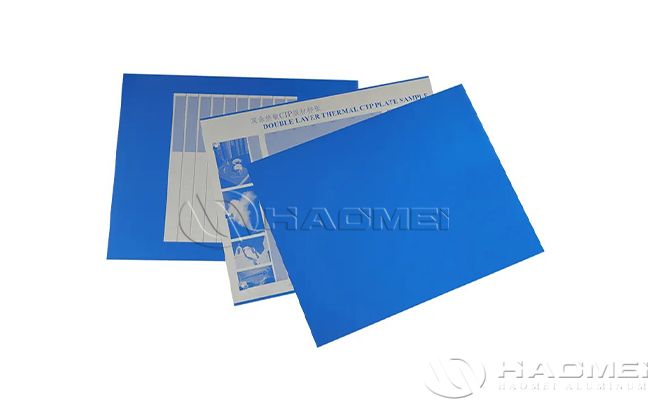Long Run Double Layer Thermal CTP Plate
Long run double layer thermal CTP plate
is a specialized material for the printing industry with high abrasion
and print resistance for long time and high speed printing. The double
layer structure design improves plate stability and printing results
while reducing the possibility of distortion and damage. Double layer
thermal CTP plates have an important position in the printing industry,
which can maintain high quality printing effect during the printing
process, improve production efficiency and save production cost.

The structure of long run double layer thermal CTP plate typically includes multiple key layers to achieve its unique imaging and printing properties. Specifically, the structure may include:
- Aluminum backing layer: serves as the bottom support of the plate and provides a stable substrate.
- Photographic Layer: This layer typically contains infrared absorbing dyes or other thermally sensitive materials that are used to absorb the energy of the infrared laser and convert it into thermal energy, which triggers a subsequent chemical reaction.
- Protective Layer: This
layer sits on top of the photoreceptor layer and protects the layer from
the external environment, such as oxygen, moisture, etc. This layer may
be used in some designs to protect the photoreceptor layer from the
external environment. In some designs, this layer may have a special
coating structure to improve the plate's sensitivity and print
resistance.
Specifications for long run double layer thermal CTP plate may vary depending on the manufacturer and the specific application, but generally include the following key parameters:
Plate thickness: Common plate thicknesses include 0.15mm, 0.20mm, 0.24mm, 0.30mm, 0.40mm, etc. to meet the needs of different presses.
Maximum Short Edge Size: This usually depends on the capacity of the production equipment, with common maximum short edge sizes up to 1350mm or larger.
Sensitive wavelength: This is usually the infrared laser wavelength of 800-830nm, which is the standard sensitive range for thermal CTP plates.
Exposure Energy: Depending on the specific design and sensitization of the plate, the exposure energy may be between 90-120mj/cm².
Developing
temperature and time: The developing process is usually carried out at a
temperature of 23-25°C and the developing time is about 20-25 seconds.
Long run double layer thermal CTP plate have several distinctive features which make them widely used in the printing industry:
- High sensitivity: Due to the double-layer coating and special light-sensitive materials, double layer thermal CTP plates usually have extremely high sensitivity and can respond quickly to infrared laser light.
- Chemical resistance: the plate has good chemical resistance and can remain stable under various printing conditions and is not easily eroded by chemical substances.
- High print resistance: After appropriate treatment (e.g. baking), the print resistance of double layer thermal CTP plates can reach hundreds of thousands of prints, which meets the needs of long-run printing.
- Green and environmental protection: Some double layer thermal CTP plates adopt no-flush technology, which reduces the use of chemicals such as developer and reduces the pollution to the environment.
- Strong
compatibility: double layer thermal CTP plates are usually compatible
with mainstream thermal plate making machines in the market, which is
convenient for users to choose and replace.
In summary, long run double layer thermal CTP plate play an important role in the printing industry with their unique structure, diverse specifications and remarkable features. With the continuous progress of technology and the improvement of environmental protection requirements, the application prospect of double layer thermal CTP plate will be more broad.
评论
发表评论